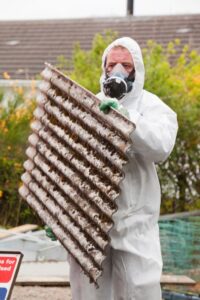SOCOTEC looks at factors to consider for asbestos management, including when asbestos is in ‘good condition’ and what this means when assessing its risk.
Asbestos cement – Introduction
 Asbestos cement products have been widely used in the UK throughout the 1900’s and can be found in commercial, industrial, agricultural and domestic properties. Cement products come in many forms including: Roofing Sheets, Wall Cladding, Rainwater Goods, Cement Flue Pipes and Soffits/Fascia panels.
Asbestos cement products have been widely used in the UK throughout the 1900’s and can be found in commercial, industrial, agricultural and domestic properties. Cement products come in many forms including: Roofing Sheets, Wall Cladding, Rainwater Goods, Cement Flue Pipes and Soffits/Fascia panels.
The use of asbestos in cement products was prohibited in the UK in 1999 but prior to that it is estimated that 6 million tonnes of asbestos cement were used in the UK over the previous 100 years making cement products the most commonly used asbestos containing material in the UK.
Asbestos cement products will generally contain between 10%-15% chrysotile (white) asbestos but have been found to contain well over 50%, particularly when weathered. Asbestos cement products that have been produced between 1945 and 1980 may also contain an amount of Crocidolite (blue) and Amosite (Brown) asbestos fibres.
Asbestos cement – Low risk?
If the asbestos cement is in good condition with the fibres firmly bound in the cement matrix it is unlikely that the asbestos fibres will become airborne and the product will present a low risk, however, the original design life of asbestos cement roofs is only between 25 and 40 years. The use of asbestos cement was banned in the UK in 1999 and many of the asbestos cement roofs are far in excess of 40 years old, in some cases 70 plus years old. Many of these roofs have degraded considerably so, is it time to review the way that asbestos cement products are risk scored and also focus on the contamination that these deteriorating products are causing to the wider environment?
Other considerations
Asbestos cement products especially roofing and rainwater goods are the ideal environment for moss, vegetation and lichens to grow.
When moss and lichens grow on cement sheeting their roots will penetrate beneath the upper layers of the cement and remove moisture. This plant growth will eventually cause an element of damage, erosion and weakness to the roof surface which in conjunction with weather conditions will eventually result in the damage of the cement product and moss/lichens being displaced onto the adjacent surfaces including roads, walkways, drains and grassed areas. These displaced plants will also include the upper layers of the roof on which they were growing.
The plant growth activity causes the cement matrix, which is essential to bind and hold the asbestos fibres in place, to break down. The result of this growth breakdown is that the cement matrix is no longer present but instead the fibres, which were once held within it are now loosely adhered to the roots of the moss/lichens. When the moss/lichens fall off the roofs this also leaves an unsealed surface with loose asbestos fibres, which can be easily displaced making the perceived low risk material now extremely friable. Eventually the moss or plant growth will compost leaving free fibre that mixes with the general site dirt and soil, which can move around by wind, rainwater or be tracked on people’s shoes and vehicle tyres.
What needs to be done?

Credit: Alamy Stock
The Control of Asbestos Regulations 2012 (CAR 2012) state as duty holders, building owners, landlords or occupants that the risk from asbestos is managed and that controls are in place to manage the risk of exposure to asbestos fibres and prevent the spread as detailed below:
Regulation 4 – Duty to manage asbestos in non-domestic premises
‘In order to manage the risk from asbestos…a suitable and sufficient assessment is carried out as to whether asbestos is, or is liable to be present…the condition of any asbestos which is, or has been assumed to be, present in the premises must be considered’.
Regulation 11 – Prevention or reduction of exposure to asbestos
‘Every employer must prevent the exposure to asbestos of any employee employed by that employer so far as is reasonably practicable’.
Regulation 16 – Duty to prevent or reduce the spread of asbestos
‘Every employer must prevent or, where this is not reasonably practicable, reduce to the lowest level reasonably practicable the spread of asbestos from any place where work under the employer’s control is carried out’.
The actual risk of asbestos cement products needs to be considered thoroughly. As with other ACMs, the material should be risk assessed and management controls put in place to reduce the potential for exposure from these products.
Factors to consider and assist the Management of Asbestos Cement Products:
- The greatest risk is contamination and the spread and controlling the contamination from anyone who may be exposed –
- Establish the extent of potential contamination (Reg 16)
- Establish whether there is the potential for individual exposure (Reg 11)
- Establish whether there is the potential for asbestos fibres to be airbourne (internal and external) (Reg 11 & Reg 16)
- Asbestos cement life span – consider how long the ACM has been in place and that the original expected life span of the material was 25-40 years
- Consider controls for the site as appropriate such as maintenance regimes required for vegetation control etc
- Consider appropriate monitoring for higher risk asbestos cement products
- Identifying primary source (roofs/rainwater goods etc) and secondary where the residue is and where it may go, i.e. moss blowing around sites, drains washing through interceptors or off site and also back flush of drains during storm events
- Information, instruction and training for all contractors
- Site operating procedures to take account of the asbestos situation, with regular updates
- Adequacy and frequency of re-inspections
- Contaminated land
Advance your career in health and safety
Browse hundreds of jobs in health and safety, brought to you by SHP4Jobs, and take your next steps as a consultant, health and safety officer, environmental advisor, health and wellbeing manager and more.
Or, if you’re a recruiter, post jobs and use our database to discover the most qualified candidates.

 Asbestos cement products have been widely used in the UK throughout the 1900’s and can be found in commercial, industrial, agricultural and domestic properties. Cement products come in many forms including: Roofing Sheets, Wall Cladding, Rainwater Goods, Cement Flue Pipes and Soffits/Fascia panels.
Asbestos cement products have been widely used in the UK throughout the 1900’s and can be found in commercial, industrial, agricultural and domestic properties. Cement products come in many forms including: Roofing Sheets, Wall Cladding, Rainwater Goods, Cement Flue Pipes and Soffits/Fascia panels.